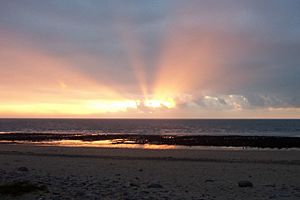Carmarthen Bay facts for kids
Carmarthen Bay (called Bae Caerfyrddin in Welsh) is a large bay on the coast of South Wales. It's like a big curve where the sea meets the land. This beautiful area is known for its amazing beaches. Some famous ones include Pendine Sands and Cefn Sidan sands. Part of Carmarthen Bay is even inside the Pembrokeshire Coast National Park. It's also recognized as a Special Area of Conservation because of its important nature.
Contents
Exploring Carmarthen Bay's Geography
Carmarthen Bay is where several rivers meet the sea. The River Loughor flows into the bay at the Burry estuary. The rivers Tywi, Taf, and Gwendraeth all join together at the Three Rivers Estuary.
Near the town of Tenby, you'll find Caldey Island in the bay. Many towns and villages are located along the bay's coast. These include Llanelli, Burry Port, Pembrey, Kidwelly, Ferryside, Llansteffan, Laugharne, Pendine, Amroth, Wisemans Bridge, Saundersfoot, and Tenby. The bay also has lovely beaches at Pendine Sands, Cefn Sidan, Laugharne, Llansteffan, and Ferryside.
Amazing Wildlife in Carmarthen Bay
Carmarthen Bay and its river mouths are listed as a Special Area of Conservation. This means it's a very important place for nature. A group called the Joint Nature Conservation Committee helps protect this area.
The bay has many different types of natural places. These include sea inlets, tidal rivers, and estuaries. You can also find mud flats, sand flats, and salt marshes. These areas are home to a huge variety of sea creatures and plants.
Cool Creatures and Plants
The sand and mud flats are full of tiny animals called bivalve molluscs. One common type is the edible cockle. These are small shellfish that live in the sand. The large, shallow parts of the bay are perfect homes for many different sea invertebrates.
The salt marshes are also very special. They have unique plants like glasswort (Salicornis species) and dwarf eelgrass (Zostera noltei). You might also spot sea rush (Juncus maritimus) and marsh-mallow (Althaea officinalis). All these plants support lots of other wildlife.
One main reason Carmarthen Bay is protected is a special fish called the twait shad (Alosa fallax). This fish travels between fresh water and the sea, and the bay is a crucial spot for it.
Wind Turbine Testing in the 1980s
In the 1980s, a part of the Carmarthen Bay coastline was used for an interesting project. Near Burry Port, scientists tested different types of wind turbines. The very first turbine started working in November 1982.
Over the years, five different wind turbine designs were tested there. The project lasted until the late 1990s. After the tests were finished, the turbines were taken down. The land where they stood is now part of the beautiful Millennium Coastal Park.


